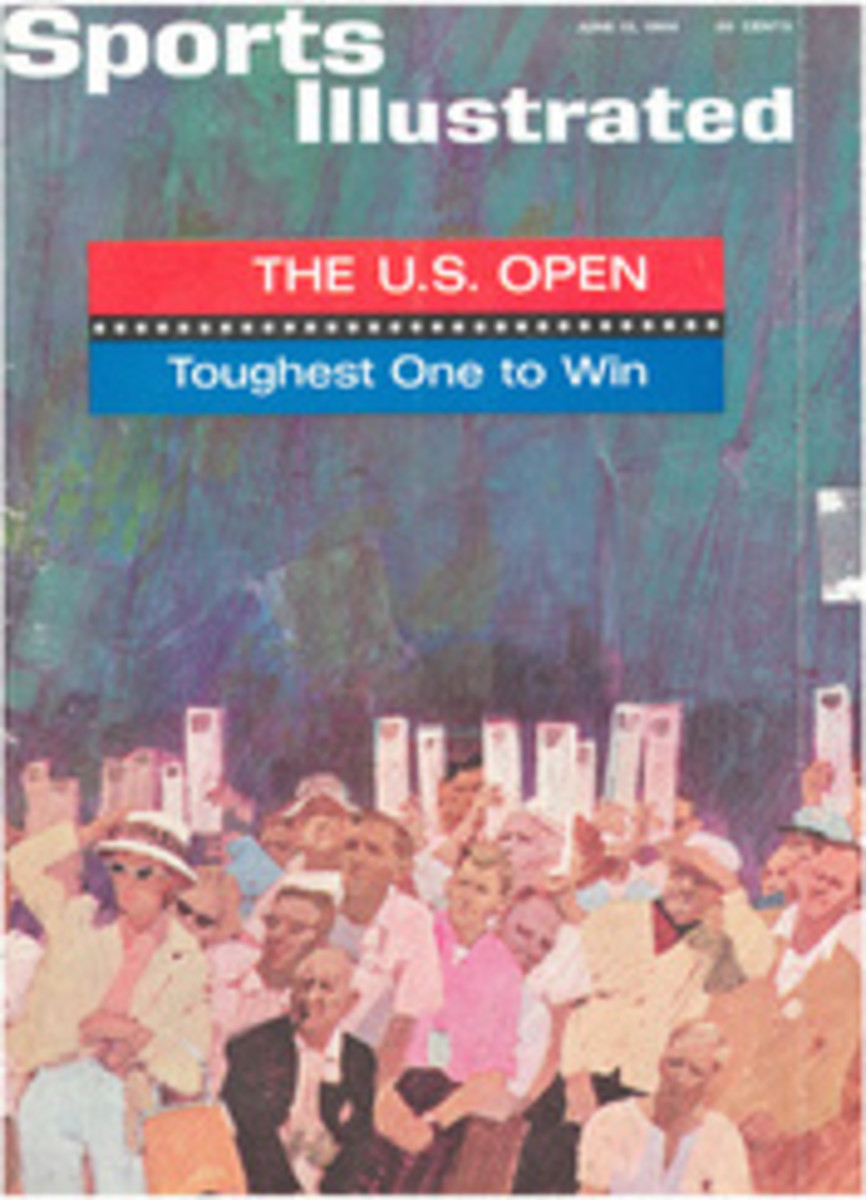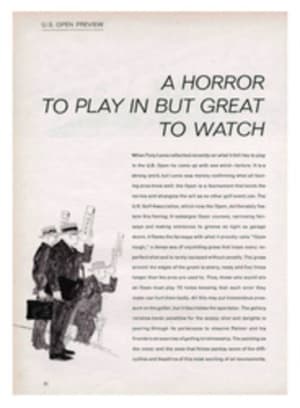
A VERY FAST CROWD AT THE TAPE
It has been exactly a decade since England's Roger Bannister flung himself across the finish line into near-unconsciousness, becoming the first ever to run a mile in under four minutes. Last week, fittingly enough, it was California that provided Bannister's historic moment with a suitably inspired celebration. At the Compton Invitational, no less than eight runners in the same race duplicated his feat. It was California's way of saying that the state was living up to its vaunted reputation as the major track center of the country. Led by spindly Dyrol Burleson (3:57.4), who—far from losing consciousness at the finish—was glancing back over his shoulder to see what was keeping the others, the group thundered across the finish line like stampeding ostriches. The race represented the most successful assault ever made on the four-minute mile. Trailing in eighth place at 3:59 was a lanky high school junior from Wichita, Kans., 17-year-old Jim Ryun. It was the first time that anyone of such tender age had run the mile faster than Bannister.
Remarkably, this theatrical display of U.S. miling strength-in-depth on Comp-ton's fast, pale-pink clay track was over-shadowed by another performance—one that brought the crowd of 7,800 to its feet. Their cheers were for Bob Schul and the event was the 5,000 meters, a race in which the U.S., until recently, has been notable only for its Olympic failures. Schul may put an end to the embarrassments of the past. His reputation in North America as a distance runner has been buried under those of Canada's Bruce Kidd, North Carolina's Jim Beatty and various other visiting dignitaries from Australia and New Zealand. He is, however, a distance runner with the speed to run a mile in close to four minutes and the strength to work, work, work. He is 26 and, after four years in the Air Force, a junior at Miami of Ohio. For three years and four months he worked closely with distance-running Coach Mihaly Igloi, the disciplinarian who helped bring Beatty to his peak.
"I think I'm mature enough now to work on my own," says Schul. "When I'm hurt I don't work out. When I was with Igloi and complained about an injury he thought I was dogging it. Now I'm getting the best of both systems."
Results prove his point. In the Comp-ton 5,000-meter run he stayed back with the pack while the two youngsters, 20-year-old Kidd and 17-year-old Gerry Lindgren, the high school boy wonder from Spokane, flitted in and out of the lead like excitable foxhounds. Then, with three laps to go, Schul jumped to the front, pulling New Zealand's ancient Bob Baillie with him. Baillie appears to have no neck; his bony head, squashed between his hunched shoulders, gives him a furtive, relentless quality that could scare anyone running behind him. But Schul was in front, and he was suddenly flying away from Baillie. Coming out of the first turn of the last lap he got up on his toes and sprinted as if the tape were just 50 yards ahead of him. It was 300.
"I knew he wouldn't jump me on the turn," said Schul of Baillie, "because I could see his shadow. But when his shadow disappeared I thought, 'Let's get out of here.' " Schul raced the last quarter in 56 seconds and posted a time of 13:38, 21 seconds faster than he had ever gone the distance before. He had a U.S. record and was just three seconds off the world mark. Lindgren was six seconds back in fourth place.
For the mob of strong runners in the mile this was to be a critical race. Spring is turning into summer, and summer brings with it the National Collegiate and AAU championships, followed almost immediately by the Olympic trials. There is not much time to gain the physical and tactical sharpness that the mile demands in a major championship.
Burleson regarded the Compton mile as the final pre-AAU test. It would show how far nine months of extraordinary training had carried him. Over that period of time this country's premier miler, who sells insurance in Eugene, Ore. during rare moments away from the track, has logged close to 5,000 miles on the dead run. This represents a 40% stepup over any of his previous work programs. Despite his severe dedication to the pursuit of an Olympic gold medal, Burleson maintains an indolent, engaging sort of charm. He seemed confident, certainly of his physical condition, the morning of the race.
"This is going to be a difficult season for all of us," he said. "We must get sharp for the nationals and the first Olympic trials, stay sharp for the Russian dual meet in late July, then be sharp again in the fall for the second trials and the Games themselves. We must be sharp enough to make the team while on the other hand we mustn't burn ourselves out. I haven't had enough competition to tell me just how sharp I am. Tonight may tell me something."
One thing his opponents do not need to be told about Burleson is that he is a fierce, aggressive runner who likes only one thing more than a fast, tactical race and that is winning a fast, tactical race. His backlog of extremely hard training and his explosive speed have supplied him with a deep sense of confidence that is going to make him awfully hard to beat, at least on the national level. Tom O'Hara, who was 0 for 5 against his Oregon rival, considered these things as he prepared for his sixth attempt. He also counted on the Compton mile to tell him something, hopefully something wonderful. Two floors above Burleson in the same hotel he flicked his hand against an entry list that also included Jim Grelle (a dozen sub-four-minute miles), Cary Weisiger (eight sub-fours) and the University of Oregon's Archie San Romani Jr. (a best this year of 4:01.2).
"These are the guys I'm going to have to beat to make the Olympic team," he said. "It's important for me to find out where I stand and what I have to do."
O'Hara had been in Los Angeles all week, flogging himself through a series of stiff workouts on the University of Southern California track and in grassy Lafayette Park across the street from his hotel. "I've been working hard," he continued, "but I'm still learning my limitations and my capabilities. To beat Burleson I would like a fast pace, but I'm not going to set it myself. It's too hard on you mentally, you know? I'm hoping that Weisiger will set it."
Last year Weisiger, a tall, broad-shouldered graduate of Duke (class of '60) and the U.S. Marines ('63), set such a scorching pace over the last 600 yards that six runners, led by New Zealand's Peter Snell in 3:55, broke four minutes. That was an all-out gamble to beat Snell. This year he had a different plan—to "stay back and see what happens."
As most milers will explain, their race is really two races. One covers the first three quarters, the jockeying for position, the testing out of pace. The other is the wild sprint over the last quarter. At Compton on Friday night the field finished the first race bunched together like straphangers in the subway with Burleson and O'Hara jammed in the middle. The approximate time was a sluggish 3:02. Then the entire group came to life. They sprinted in a body down the backstretch. Suddenly Burleson burst out of the group, swung wide coming out of the last turn and, looking back over his right shoulder for O'Hara, led the flock across the finish line. It was a judge's and timer's nightmare, a blanket of 1.6 seconds covering the group of eight.
"I was surprised when O'Hara didn't come at me in the stretch," said Burleson, who considered the race much too easy to be a real test. In fact, he even enjoyed the pushing and jostling that went on throughout.
"I didn't have the zip I had indoors," said O'Hara, drained from his efforts. "Maybe I've been working too hard."
For Burleson the significance of the race lay in the fact that a high school junior ran 3:59. For Ryun's coach, Bob Timmons, there was confirmation of a privately held theory: trackmen can be trained as intensively as teen-age swimmers and perhaps some day break as many records.
"We should look to the swimmers for inspiration," he said.
Burleson and O'Hara and San Romani were not looking out for swimmers, necessarily, but at 7:30 the next morning they were out in Lafayette Park in their warm-up suits, going round and round. Any Olympic hopeful has to.
PHOTO
Relaxed and enjoying his easy win, Dyrol Burleson floats across finish ahead of exhausted Tom O'Hara and six other sub-four-minute milers.

